Beach vs Grass: Best Surfaces for Soccer Tennis
Soccer tennis is a fun and challenging game, but the surface you play on - beach sand or grass - can significantly change your experience. Here's a quick breakdown to help you decide:
Key Differences:
-
Beach Sand:
- Requires more energy, making it a full-body workout.
- Encourages aerial play due to limited dribbling.
- Offers excellent joint cushioning but challenges balance and stability.
- Maintenance involves raking and sand replenishment.
- Ideal for high-intensity training and strength building.
-
Grass:
- Allows smoother, faster movements with traditional soccer techniques.
- Provides consistent ball control and moderate joint impact.
- Requires regular mowing, watering, and fertilization.
- Perfect for skill refinement and a balanced pace of play.
Quick Comparison:
| Aspect | Beach Sand | Grass |
|---|---|---|
| Movement Style | Aerial, limited dribbling | Traditional soccer techniques |
| Energy Cost | Very high | Moderate |
| Ball Control | Unpredictable | Predictable |
| Maintenance | Raking, sand leveling | Mowing, watering, fertilizing |
| Setup Cost | $22,000–$35,000 | $50,000–$110,000 |
| Injury Risk | Back and knees | Ankles and knees |
Bottom Line:
Choose beach sand for a high-energy workout that builds strength, or grass for smoother gameplay and skill development. Both surfaces offer unique benefits, so pick based on your goals and local conditions.
How Each Surface Affects Play
Ball Movement on Each Surface
The way the ball interacts with different surfaces is a game-changer in soccer tennis. On beach sand, the ball's bounce is unpredictable. The sand absorbs much of the ball's energy, leading to erratic trajectories and lower rebound heights. This forces players to adapt quickly to the uneven and challenging conditions.
Grass, on the other hand, offers more consistent ball movement. When well-maintained, it allows for faster rebounds compared to sand, although the ball may bounce lower than it would on hard surfaces. However, wet or muddy grass can throw a curveball, making the surface slippery and causing the ball to skip in unexpected ways. These differences in ball behavior highlight how each surface uniquely influences the way the game is played.
Player Speed and Energy Use
The differences in ball movement on sand and grass also affect how players move and expend energy. Sand, with its natural resistance, demands significantly more energy. For example, young players on sand spend about 74% of their time in high-intensity activity zones, with heart rates soaring to roughly 95% of their maximum. The unstable surface also requires greater balance and strength, adding to the challenge.
Grass, by contrast, provides a more forgiving and stable surface. Its natural elasticity and reliable traction allow for smoother and faster movement. However, wet or muddy grass can reduce stability and increase the risk of slipping.
Here’s a quick comparison of how the two surfaces stack up:
| Aspect | Beach Sand | Grass |
|---|---|---|
| Energy Cost | Very high due to surface resistance | Moderate with better energy return |
| Movement Speed | Slower and more demanding | Faster and more fluid |
| Heart Rate | ~74% in high-intensity zones | Lower intensity, smoother movement |
| Surface Stability | Unstable, requiring extra balance | Stable with reliable traction |
Training on sand pushes players to their physical limits, strengthening muscles in the knees, ankles, and feet that often don’t get as much attention. Grass, with its stability, shifts the focus to refining technique and ball control, offering a balanced approach to improving overall gameplay.
Differences Between Tennis Court Surfaces
Required Gear and Setup
The right equipment can make or break your soccer tennis experience, especially when switching between beach and grass surfaces.
Best Shoes for Each Surface
Your choice of footwear plays a huge role in both performance and safety. On the beach, most players prefer to go barefoot, which allows for better control and connection with the sand. If you're looking for a bit of protection, sand socks are a great option - they shield your feet while still letting you feel the surface beneath.
For grass, the stakes are different. Turf cleats (TF) are ideal for short-cut natural grass, offering solid grip without tearing up the field. On artificial grass, AG boots designed specifically for 3G and 4G pitches provide better traction and help reduce the risk of injuries.
Now that your feet are covered, let’s talk about the ball and net setup.
Choosing Balls and Nets
Footwear isn’t the only thing that impacts gameplay - your ball and net choices matter just as much.
For beach soccer tennis, you’ll want a lighter, softer ball with reduced air pressure (0.4–0.6 atm). A great example is the Kickit Soccer Tennis Ball, which maintains size 5 dimensions but weighs about half as much as a standard soccer ball. This makes it perfect for barefoot play and headers.
On grass, you have more flexibility in ball selection. However, proper inflation (0.6–1.1 atm) is key to ensuring a consistent bounce and good control. Look for water-resistant and durable balls that can withstand varying weather conditions.
When it comes to nets, here’s a quick comparison of what you’ll need for each surface:
| Equipment Aspect | Beach Setup | Grass Setup |
|---|---|---|
| Net Height | 2'8" | 2'8" |
| Net Width | 10' | 10' |
| Surface Prep | 3,000 kg silica sand per court | Regular mowing |
| Maintenance | Sand distribution, water settling | Net tension checks |
A portable option like the Kwik Goal All-Surface Soccer Tennis Net is a solid choice. It features a steel frame, elastic cord, and quick setup, plus it comes with a convenient carry bag.
For beach setups, you’ll need to distribute sand weekly and add about 100 kg per court each month during the first six months. On grass, regular net tension checks and adjustments will keep your setup in top shape.
With the right gear, you’ll be ready to play no matter the surface!
Weather and Upkeep Needs
Keeping courts in top shape isn't just about the equipment - it also comes down to how well they handle weather and how they're maintained. Beach and grass courts react differently to environmental conditions, and their upkeep routines reflect those differences.
Rain and Water Effects
When it comes to dealing with water, beach sand and grass couldn't be more different. Sand courts, especially those made with silica sand, are naturally equipped to drain water efficiently. This drainage keeps the surface stable and playable even after a heavy downpour. On the other hand, regular beach sand tends to absorb water, turning into a sticky paste that can interfere with gameplay.
"Beach sand absorbs water creating a paste, silica sand works as a filter and avoids retaining moisture in the court, while contributing to better stability for this reason." – MejorSet
Grass courts, however, face a tougher challenge. Wet grass becomes slippery and muddy, which not only makes playing risky but also damages the surface. To avoid long-term issues, it's crucial to let the grass dry out fully before resuming play. These weather-related challenges mean both surfaces need specific care routines to stay in shape.
Daily and Weekly Care
Each surface has its own maintenance rhythm, and staying on top of it is key to ensuring quality play. Here's a quick breakdown:
| Maintenance Task | Beach Surface | Grass Surface |
|---|---|---|
| Daily Care | Morning raking to clear debris | Remove debris like leaves and twigs |
| Weekly Tasks | Deep raking, leveling | Mowing and edge trimming |
| Monthly Care | Redistribute sand | Fertilization and weed control |
| Additional Tasks | Replenish sand as needed | Maintain a consistent watering schedule |
Beach courts call for daily raking to keep the sand even and free from debris. Uneven sand can mess with the ball’s bounce and movement, so regular redistribution is necessary. Sand replenishment might also be required occasionally to maintain the court's depth and consistency.
Grass courts demand more attention. Beyond mowing to keep the grass at the right height, you'll need to:
- Keep an eye on irrigation, especially during hot months,
- Clear organic debris to prevent decay,
- Rotate court usage to minimize wear and prevent bare patches, and
- Regularly trim the edges for a clean look.
For facilities looking for a middle-ground option, artificial turf might be worth considering. While it doesn't require mowing or fertilizing, it does come with its own set of needs, like weekly brushing to keep the fibers upright and cleaning to prevent moss or algae buildup. This makes it a practical choice for those seeking a surface that balances weather resistance with manageable upkeep.
Safety and Risk Factors
Choosing between beach and grass surfaces for soccer tennis involves understanding how each impacts player safety and health. Knowing these factors can help you align your playing style with the demands of the surface.
Impact on Player Health
Sand offers excellent shock absorption, which helps reduce the strain on joints. However, its uneven surface can lead to lower back strain and increased knee stress, especially during sudden movements or quick changes in direction.
Grass, on the other hand, provides moderate cushioning and better overall stability. That said, wet grass can become slippery, increasing the risk of falls. The type of grass also matters - Ryegrass fields, for example, are less likely to trap cleats during sharp movements, potentially lowering the risk of ACL injuries compared to Bermuda grass.
| Safety Factor | Beach Surface | Grass Surface |
|---|---|---|
| Impact Absorption | Excellent shock absorption | Moderate cushioning |
| Injury Risk Areas | Back and knees | Ankles and knees |
| Surface Stability | Varies with sand depth | Depends on maintenance |
| Weather Impact | Minimal safety concerns when wet | Becomes slippery when wet |
| Traction | Limited, requires adaptation | Good when dry, poor when wet |
Tips for Safer Play
To reduce injury risks and improve safety, consider these practical measures:
- On Sand: Use a knee brace for added support and focus on controlled movements rather than explosive actions.
- On Grass: Wait for the surface to dry fully after rain, and wear footwear with adequate grip to prevent slipping and ankle injuries.
sbb-itb-8dc5da3
Price and Location Options
When choosing a surface for soccer tennis, it’s essential to weigh both upfront installation costs and ongoing maintenance expenses. These factors, along with local conditions, play a significant role in determining the best option for your needs.
Setup Costs vs. Maintenance Fees
Building a beach-style court comes with an estimated price tag of $35,000 for professional installation. This cost typically includes essentials like drainage systems, sand delivery, and boundary setup. On the other hand, natural grass courts are more expensive to establish, with initial costs ranging from $50,000 to $110,000. However, if you’re working with an existing grass area, such as in a park, modifications can often be made at a much lower cost.
| Cost | Beach Surface | Grass Surface |
|---|---|---|
| Initial Setup | $22,000 – $35,000 | $50,000 – $110,000 |
| Annual Maintenance | Lower upkeep | $18,000 – $44,000 |
For those not ready to commit to permanent infrastructure, portable options like Kickit’s soccer tennis sets (priced between $79.99 and $129.99) offer a budget-friendly way to experiment. These sets allow you to play on either surface without the need for major construction, making them a practical choice for testing out the sport before investing in a dedicated court.
How Location Impacts Costs
Geography also plays a big role in determining costs. If you’re near the coast, building a beach court may be more affordable due to easier access to sand and other materials. Conversely, inland areas often have more park spaces, making grass courts a more practical and cost-effective option. By leveraging the resources available in your area, you can strike the right balance between performance and budget.
Playing Tips for Each Surface
Each playing surface comes with its own quirks and challenges. Here’s how you can adapt your game to perform at your best, whether you’re on sand or grass.
Beach Play Techniques
Playing on sand is a whole different ball game - literally. The soft, shifting ground affects movement and power, making it crucial to tweak your approach. For example, studies show that jump heights on sand are 19.8% lower compared to solid ground. Here’s how to tackle the challenge:
- Ball Pressure: Pump up the ball slightly above its regular pressure to counteract the energy absorption of the sand. The Kickit Pro Ball works best when inflated to its maximum recommended pressure, especially for beach play.
- Movement and Shot Selection: A wide stance is your best friend on sand - it keeps you stable and ready for the ball’s unpredictable path. Aim for high volleys and aerial shots to offset the sand’s tendency to deaden bounces, giving you better control on uneven terrain.
Grass Court Tactics
Grass courts offer a different set of opportunities. The surface is firmer and faster, allowing for more dynamic play. Here’s how to make the most of it:
- Ground Game: Grass provides a consistent bounce, making it ideal for precise ground shots. It also enhances the stretch-shortening cycle, which can boost your explosiveness and energy return.
- Speed Adaptation: Stay close to the net to capitalize on the surface’s quicker pace. This positioning helps you react faster and dominate the game.
- Surface Awareness: Grass conditions can change after rain, so keep an eye on how it affects ball movement. Position yourself squarely to maintain control in slippery or damp spots. The Kickit Soccer Tennis Pro set includes boundary markers designed to stay visible even in wet conditions.
| Technique | Beach Surface | Grass Surface |
|---|---|---|
| Recommended Shot Type | High volleys, aerial play | Controlled ground shots |
| Suggested Movement Approach | Wide stance, measured steps | Explosive sprints |
| Required Power | Higher power needed | Moderate power sufficient |
Surface Comparison Chart
Here’s a detailed breakdown comparing the performance and upkeep of beach sand and grass surfaces.
Key Differences Table
| Feature | Beach Sand | Grass |
|---|---|---|
| Ball Movement | • Significant energy loss on impact, affecting shot precision • Unpredictable bounce patterns demand adaptable gameplay |
• Fast, low-skidding bounces • Predictable trajectory supports high-speed games |
| Physical Impact | • Reduces jump height, requiring more energy • Sand cushioning offers natural joint protection |
• Promotes explosive movements with elastic energy return • Moderate impact on joints due to stable footing |
| Surface Stability | • Demands a wider stance and improved balance | • Allows quick directional shifts when dry |
| Maintenance Needs | • Needs regular raking and leveling • Occasional sand replenishment |
• Requires frequent mowing, watering, and fertilizing |
| Weather Impact | • Heat raises surface temperature • Wind alters play dynamics |
• Wet conditions decrease traction • Wear impacts bounce consistency |
| Annual Maintenance Cost | • Lower overall upkeep | • Higher maintenance demands |
Natural grass courts are a significant investment, with installation costs ranging from $1.8 million to $2.5 million. In addition, maintaining them involves regular expenses for mowing, irrigation, and fertilization.
Conclusion: Which Surface Fits Your Needs
Choosing the right surface ultimately hinges on your objectives and environment.
Beach sand might be your go-to if you're aiming for:
- Building explosive strength and improving joint stability
- A workout that demands about 24% more energy, pushing your limits
- Natural cushioning to lower injury risk, especially during recovery or rehab
Grass, on the other hand, is ideal if you’re after:
- A faster-paced game with traditional ball movement
- Lower energy demands, allowing for quick directional shifts
- A surface that works well across multiple sports and supports classic techniques
Each surface offers unique advantages. For example, sand training has been shown to boost lower-limb strength asymmetry by 41.1% in side hop jump tests, making it a powerful option for strength-focused training.
Don’t forget to consider your local climate and upkeep requirements. Sand courts need regular leveling to stay in top shape, while grass fields demand consistent mowing and irrigation to maintain their quality.
FAQs
What should I consider when deciding between playing soccer tennis on beach sand or grass?
When deciding between beach sand and grass for soccer tennis, it's important to weigh how each surface impacts gameplay, equipment, and the overall experience.
Beach sand offers a softer surface that absorbs impact, which can help reduce the risk of injuries. However, its resistance can make movement slower and more challenging. Grass, in contrast, allows for quicker, more dynamic play. That said, wet grass can become slippery, potentially affecting traction and stability.
Your choice of equipment also changes with the surface. On sand, players often go barefoot or opt for lightweight footwear to better navigate the terrain. On grass, cleats are usually essential for improved grip and control. The environment matters too - beach sand courts are typically found in coastal areas, while grass fields demand consistent upkeep and are more influenced by weather.
Ultimately, the best surface depends on your playing style, preferences, and what’s available in your area.
How does playing soccer tennis on sand compare to grass in terms of fitness benefits and injury risks?
Playing soccer tennis on sand provides some standout fitness perks while also lowering the risk of certain injuries compared to playing on grass. The soft, shifting surface of sand forces your feet and ankles to work harder, activating more muscles and improving balance and stability over time. This extra effort can boost overall physical fitness and help players become more resistant to injuries. Plus, sand’s shock-absorbing nature helps protect your joints by reducing impact, which lowers the chance of sprains or other sudden injuries.
Grass, on the other hand, offers a firmer and more stable playing surface, but it comes with its own risks. The harder ground can lead to more stress-related injuries, especially in the legs and feet. While grass allows for quicker movements, it doesn’t cushion impacts as well as sand, which could increase the likelihood of joint strain. In short, sand is a better option for building fitness and protecting your joints, while grass requires a bit more care due to its unforgiving surface.
What are the costs of setting up and maintaining soccer tennis courts on beach sand vs. grass?
The cost of building and maintaining soccer tennis courts largely depends on the type of surface you choose.
Beach sand courts are typically the more budget-friendly option, with installation costs ranging from $7,200 to $30,600. Maintenance is relatively simple compared to grass courts, though you’ll need to account for periodic sand grooming and occasional replenishment to keep the surface in good condition.
Grass courts, however, come with a heftier price tag. Installing a regulation-sized grass court can cost anywhere from $25,000 to $120,000. On top of that, annual maintenance expenses - covering tasks like irrigation, mowing, and fertilization - can run between $1,500 and $10,000. Despite the higher costs, grass courts offer a distinct playing experience that many players find appealing.
Choosing between these surfaces comes down to your budget, personal preferences, and how much effort you’re prepared to invest in maintenance.

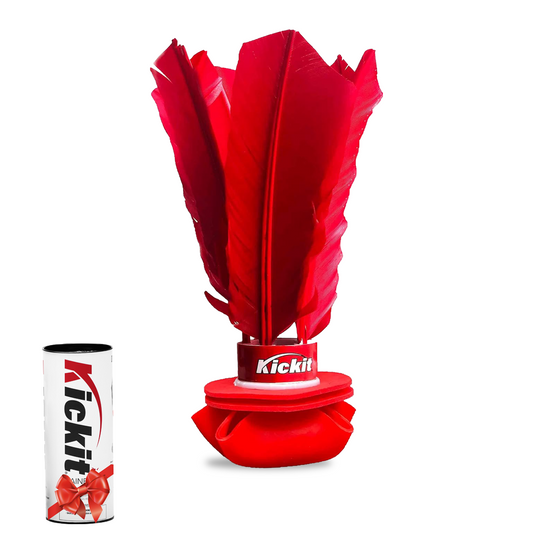
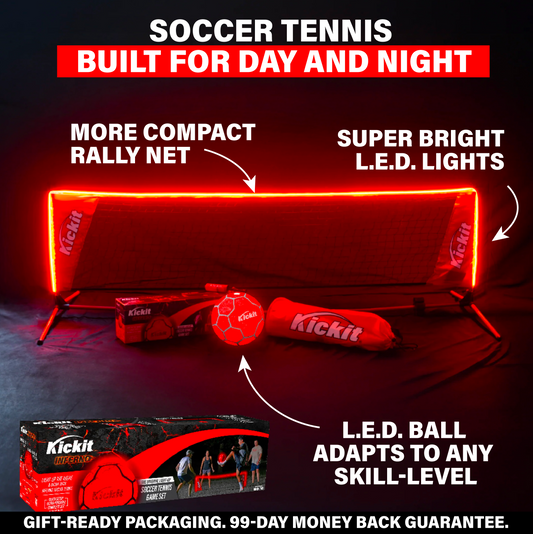
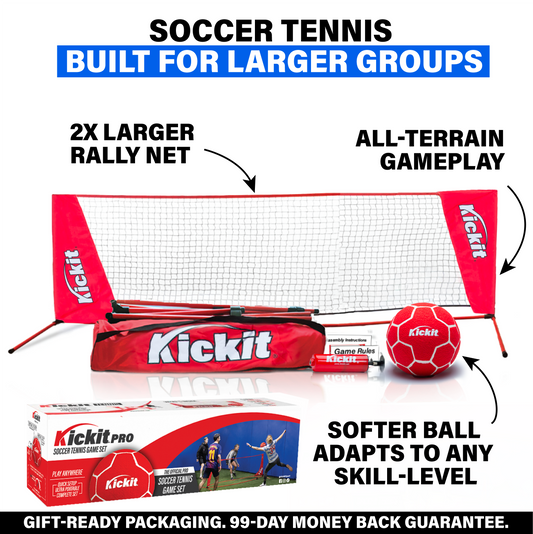
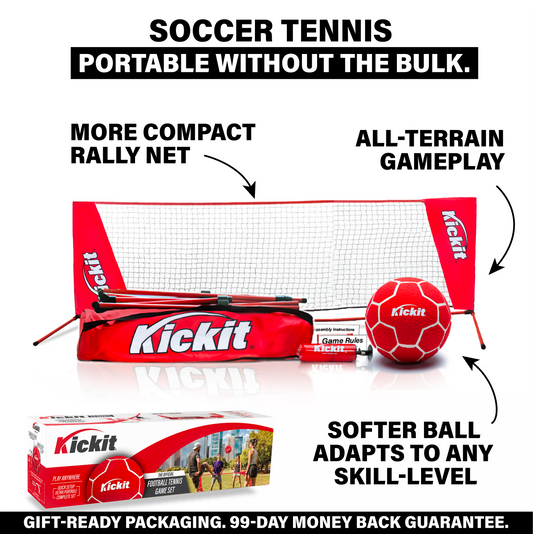
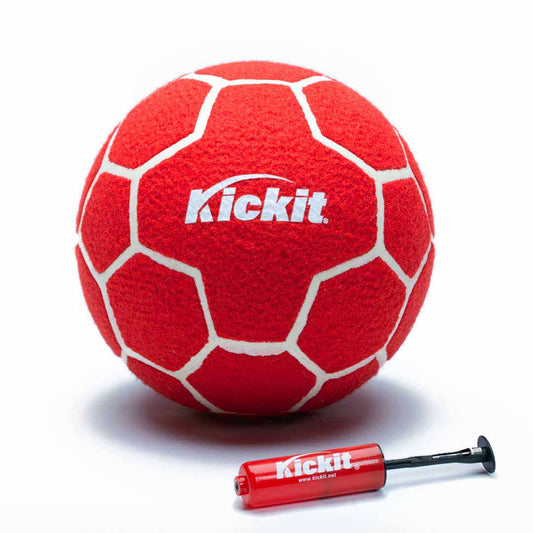
![[NEW] Inferno Kickit](http://kickit.net/cdn/shop/files/LED-Trainer_callouts.png?v=1761855747&width=533)
